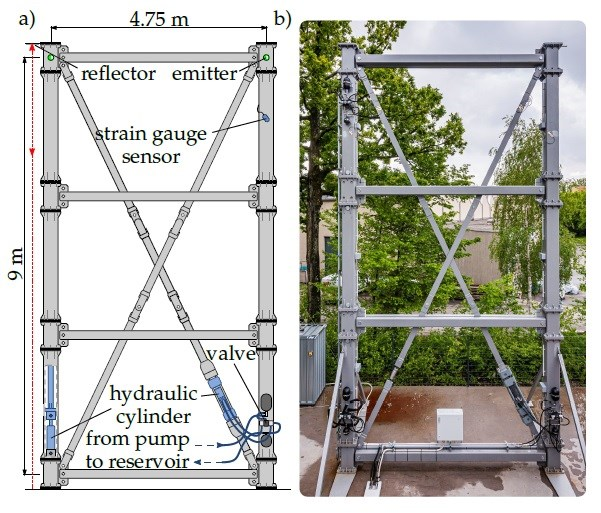Mar 17 2020
A novel camera-based technique developed for detecting building deformations can identify tiny displacements from a distance of just 10 m.
 The researchers applied their new camera-based method for measuring building deformations to monitor very small movements of an adaptive building prototype frame 9 meters tall. Image Credit: Flavio Guerra, University of Stuttgart.
The researchers applied their new camera-based method for measuring building deformations to monitor very small movements of an adaptive building prototype frame 9 meters tall. Image Credit: Flavio Guerra, University of Stuttgart.
This camera-based technique could enable continuous detection of rapid deformations that occur in many large structures, including bridges and high-rise buildings, with the goal to adapt these structures to external forces.
Our new approach to detect building deformations could be used to continuously monitor movements. For bridges, the measured deformations could be used to counteract external loads such as a truck traversing the bridge, thereby increasing the lifetime of the bridge. Because it operates in real time, it could be used to set off an alert the moment any new deformations—which can lead to cracks—were detected.
Flavio Guerra, Researcher, University of Stuttgart
Headed by Tobias Haist, a research team has detailed the latest method in Applied Optics—the journal of Optical Society (OSA). The study was carried out as part of a research that intends to create the technology required to construct buildings that attune to environmental conditions such as earthquakes, wind, air temperature, and sunlight.
One day we could have lightweight buildings that change forms in response to complex wind forces and can stay still during an earthquake. This type of adaptation requires extremely precise building deformation measurement so that the building’s current state is estimated and the direction in which it will likely move can be predicted.
Flavio Guerra, Researcher, University of Stuttgart
A Vision-Based Method
In the new camera-based technique, a camera is fixed to a tripod that is located at a small distance away from the front of the building. Tiny light emitters are attached to the same building. This camera subsequently identifies whether the light sources shift in relation to one another. A hologram produced by a computer is utilized to produce numerous copies of each image of the light source on the image sensor.
Measurement errors, like noise, are reduced by averaging the movement of the numerous copies of the laser spot. This method ensures the measurement uncertainties are less than a hundredth of a pixel. That accuracy can be further improved by utilizing numerous cameras and help apply the method to extremely massive structures.
Even though fiber optic sensors can be utilized for monitoring structural health, they should be set up when the building is constructed. After construction, the latest camera-based system can be fixed to the building. This camera-based system utilizes hardware that is inexpensive when compared to fiber optic systems.
The multi-point measurement approach we used is based on a relatively simple method developed for the control of coordinate measurement machines. However, we applied the multi-point method for the first time on large objects outdoors under changing environmental conditions in real-time.
Flavio Guerra, Researcher, University of Stuttgart
The scientists emphasized that a majority of the camera inspection systems illuminate the object—a building in this example—and can subsequently capture its image with the help of a camera. The researchers adopted another method by fixing small light emitters to the building and then guiding the resultant light directly toward the camera. This arrangement enables faster and more precise measurements because more light is received by the camera.
Monitoring an Adaptive Structure Prototype
The scientists applied their latest technique to track extremely tiny movements of an adaptive building prototype frame that has a height of 9 m. The measurements made by the researchers corresponded well with the data provided by a strain gauge sensor and vibrometer for the model.
The scientists have now planned to utilize the system to quantify the movement that occurs in original buildings. They also intend to make the software more redundant and powerful so that it can be used reliably for 24 hours constant measurement in a day.